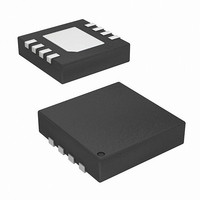ISL1208IRT8Z-TK Intersil, ISL1208IRT8Z-TK Datasheet - Page 18

ISL1208IRT8Z-TK
Manufacturer Part Number
ISL1208IRT8Z-TK
Description
IC RTC/CALENDER I2C 8-TDFN
Manufacturer
Intersil
Type
Clock/Calendar/NVSRAMr
Datasheet
1.ISL1208IB8Z-TK.pdf
(24 pages)
Specifications of ISL1208IRT8Z-TK
Memory Size
2B
Time Format
HH:MM:SS (12/24 hr)
Date Format
YY-MM-DD-dd
Interface
I²C, 2-Wire Serial
Voltage - Supply
2.7 V ~ 5.5 V
Operating Temperature
-40°C ~ 85°C
Mounting Type
Surface Mount
Package / Case
8-TDFN
Lead Free Status / RoHS Status
Lead free / RoHS Compliant
Available stocks
Company
Part Number
Manufacturer
Quantity
Price
Company:
Part Number:
ISL1208IRT8Z-TK
Manufacturer:
Intersil
Quantity:
1 000
Application Section
Oscillator Crystal Requirements
The ISL1208 uses a standard 32.768kHz crystal. Either
through hole or surface mount crystals can be used. Table 6
lists some recommended surface mount crystals and the
parameters of each. This list is not exhaustive and other
surface mount devices can be used with the ISL1208 if their
specifications are very similar to the devices listed. The
crystal should have a required parallel load capacitance of
12.5pF and an equivalent series resistance of less than 50k.
The crystal’s temperature range specification should match
the application. Many crystals are rated for -10°C to +60°C
(especially through hole and tuning fork types), so an
appropriate crystal should be selected if extended
temperature range is required.
Crystal Oscillator Frequency Adjustment
The ISL1208 device contains circuitry for adjusting the
frequency of the crystal oscillator. This circuitry can be used
to trim oscillator initial accuracy as well as adjust the
frequency to compensate for temperature changes.
The Analog Trimming Register (ATR) is used to adjust the
load capacitance seen by the crystal. There are six bits of
ATR control, with linear capacitance increments available for
adjustment. Since the ATR adjustment is essentially “pulling”
the frequency of the oscillator, the resulting frequency
changes will not be linear with incremental capacitance
changes. The equations which govern pulling show that
lower capacitor values of ATR adjustment will provide larger
increments. Also, the higher values of ATR adjustment will
produce smaller incremental frequency changes. These
values typically vary from 6ppm to 10 ppm/bit at the low end
to <1ppm/bit at the highest capacitance settings. The range
afforded by the ATR adjustment with a typical surface mount
crystal is typically -34ppm to +80ppm around the ATR=0
default setting because of this property. The user should
note this when using the ATR for calibration. The
temperature drift of the capacitance used in the ATR control
is extremely low, so this feature can be used for temperature
compensation with good accuracy.
MANUFACTURER
TABLE 6. SUGGESTED SURFACE MOUNT CRYSTALS
SaRonix
Ecliptek
Raltron
Citizen
Epson
ECS
Fox
18
ECPSM29T-32.768K
MC-405, MC-406
PART NUMBER
RSM-200S
ECX-306
FSM-327
CM200S
32S12
ISL1208
In addition to the analog compensation afforded by the
adjustable load capacitance, a digital compensation feature
is available for the ISL1208. There are 3 bits known as the
Digital Trimming Register (DTR). The range provided is
±60ppm in increments of 20ppm. DTR operates by adding or
skipping pulses in the clock counter. It is very useful for
coarse adjustments of frequency drift over temperature or
extending the adjustment range available with the ATR
register.
Initial accuracy is best adjusted by enabling the frequency
output (using the INT register, address 08h), and monitoring
the ~IRQ/fOUT pin with a calibrated frequency counter. The
frequency used is unimportant, although 1Hz is the easiest
to monitor. The gating time should be set long enough to
ensure accuracy to at least 1ppm. The ATR should be set to
the center position, or 100000Bh, to begin with. Once the
initial measurement is made, then the ATR register can be
changed to adjust the frequency. Note that increasing the
ATR register for increased capacitance will lower the
frequency, and vice-versa. If the initial measurement shows
the frequency is far off, it will be necessary to use the DTR
register to do a coarse adjustment. Note that most all
crystals will have tight enough initial accuracy at room
temperature so that a small ATR register adjustment should
be all that is needed.
Temperature Compensation
The ATR and DTR controls can be combined to provide
crystal drift temperature compensation. The typical
32.768kHz crystal has a drift characteristic that is similar to
that shown in Figure 17. There is a turnover temperature
(T
as it varies with the square of the difference between the
actual temperature and the turnover temperature.
If full industrial temperature compensation is desired in an
ISL1208 circuit, then both the DTR and ATR registers will
need to be utilized (total correction range = -94ppm to
+140ppm).
0
) where the drift is very near zero. The shape is parabolic
FIGURE 17. RTC CRYSTAL TEMPERATURE DRIFT
-100
-120
-140
-160
-20
-40
-60
-80
0
-40 -30 -20 -10 0
TEMPERATURE (°C)
10 20 30 40 50 60 70 80
September 12, 2008
FN8085.8












